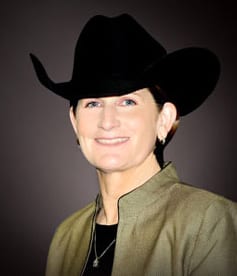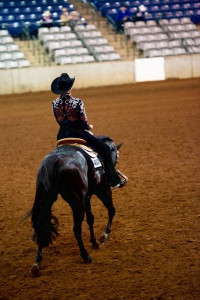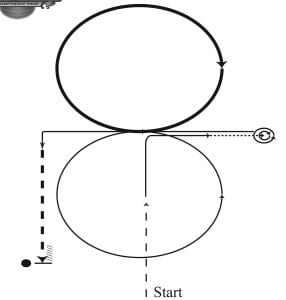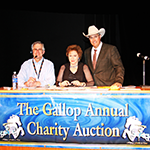One of the hardest maneuvers to master in a horsemanship or equitation pattern is, ironically, one of the most simple concepts known to mankind: a circle. In the show pen we have seen them come out like eggs, squares, and footballs. We have also seen those exhibitors who seem to nail their circles every time.
Riders of all ages have found themselves at one point or another struggling to make the “perfect circle.” Gohorseshow reached out to long time AQHA judge and horsewoman, Gretchen Mathes, to share her knowledge on how to nail your execution every time. Her advice was, ironically, pretty simple.
For Mathes, the perfect circle comes down to one basic concept: knowing your destination.
Back to Basics
Mathes said that the easiest way to execute a circle is to think of it as a clock. Think of 12:00, 3:00, 6:00, and 9:00 and use them as your points of reference. As you ride the circle, look at each point on the “clock.”
“When we teach kids how to do a circle, we use points in the arena like the gates and doors,” Mathes said, “This teaches riders how to recognize where they are in the pen. Knowing where you are in the pen and knowing where you want to be is key to pattern placement.”
In other words: know your destination.
According to Mathes, riders who know their destination can execute any pattern without cones as reference points. Of course, this includes patterns with circles.
 “It really is about using the pen as your guide and not the cones. [In a class], you need to know where the cones are but don’t look at them. That draws you in and you lose track of your destination and whereabouts in the arena.”
“It really is about using the pen as your guide and not the cones. [In a class], you need to know where the cones are but don’t look at them. That draws you in and you lose track of your destination and whereabouts in the arena.”
When a rider uses the clock strategy while executing a circle, that keeps them focused on their next destination. For Mathes, this means that riders are riding ahead. She said, “Look at the next point of your circle, this tells you and your horse where you want to be next.”
Mathes also warned against looking to the inside of the circle, “It’s just not purposeful. When you look to the inside of your circle, that draws your horse in. You quickly start to lose ground. It also looks fake, it’s not a natural picture.”
From Paper to Show Pen
As a judge, Mathes said she will “lay the pattern out” directionally before judging a horsemanship or equitation class.
 For example, if a pattern shows the exhibitor entering from a south gate and the arena runs north to south, she will study the pattern from that perspective. She recommends that exhibitors do the same when preparing for a pattern class.
For example, if a pattern shows the exhibitor entering from a south gate and the arena runs north to south, she will study the pattern from that perspective. She recommends that exhibitors do the same when preparing for a pattern class.
This means exhibitors should plan their circles from the perspective of the entrance gate.
“It’s really important to know where you are going to enter and exit when planning out a pattern,” she said, “this will determine what landmarks in the arena you choose. You also need to be aware of your space.”
Mathes suggests taking a blank piece of paper and drawing the pattern onto it. The paper serves as the confines of your arena, giving you a vision of your space and allows you to plan your execution.
“This way riders can plan out their steps and really have a solid plan,” she said. “For example, they can plan for 20 jog steps to get to their mark to start a circle or any other maneuver. Riders really should be able to feel and know their space.”
By planning out your circle (and entire pattern) from this perspective, Mathes believes exhibitors make their marks much more effortlessly, marks that can easily get missed in circle patterns.
 “I see a lot of exhibitors miss their marks when executing circles,” she said, “they haven’t planned it out right, aren’t riding with a destination in mind, and next thing you know they are 10, 20 feet off their mark. If you ride a circle with a purposeful destination in mind, it sets you up for the rest of your pattern.”
“I see a lot of exhibitors miss their marks when executing circles,” she said, “they haven’t planned it out right, aren’t riding with a destination in mind, and next thing you know they are 10, 20 feet off their mark. If you ride a circle with a purposeful destination in mind, it sets you up for the rest of your pattern.”
An often overlooked element that can ruin your circle?
Improper rein length.
Mathes said, “Sometimes I see riders with their outside rein tighter than their inside rein. This causes the horse’s nose to turn out putting them out of position and ruins your circle.”
Having overly draped reins also leads to problems.
“If you’re having to pick up your hand really high or have to bring it back to your body, you come out of a circle, and you no longer have the horse; the horse has you. Make sure your reins are short enough.”
When it comes to exhibitors who excel at circles, Mathes said: “they don’t look down. They use their leg and keep their horse between the bridle reins. They also don’t lean. [Leaning] in Horsemanship throws off your legs so you don’t have equal use of them. Finally, they don’t look in.”
Final Thoughts
As Gertrude Stein once said: “A rose is a rose is a rose.”
The concept of “things are what they are,” is exactly how Mathes believes riders should approach their circles.
“A circle is a circle,” she said, “once you have your destination in mind and can execute it, it should be the same every single time, no matter the size or the speed.”
She does, however, note one exception. If the pattern calls for a lead change after the circle.
“You have to account for space for setting up the horse for that lead change,” she said, “and that can, and should, change how you approach the circle.”
How, exactly?
Mathes said, “It’s really quite simple: When you come out of that circle you need to find that straight line, clear your horse’s shoulder, change leads, and continue to ride that straight line. This sets you up for either another circle or to continue onto the rest of your pattern.”
 Mathes also talked about how one should execute a figure eight. A maneuver, that is no doubt, the bane of some riders’ existence.
Mathes also talked about how one should execute a figure eight. A maneuver, that is no doubt, the bane of some riders’ existence.
“There should be a straight line in the center,” she said, “no X’s. In order to get a good figure eight you need to get your head off your chest and look up. You also need to have a good knowledge of the space you have so your circles are even.”
She continued, “Think of a basketball sitting on the center line of your pattern. You want two equal halves. This is how your circles should look.”
Finally, Mathes said [broke] horses have been trained to follow their nose, so when it comes to getting the perfect circle it’s really about training the rider to pilot their horse and understand their destination. If the rider doesn’t have that sense of destination in mind, the circle will fall flat (sometimes literally, think back to all those eggs and footballs).
Her last bit of advice, besides practice, practice practice? Draw circles on paper. By drawing circles over and over again, a person gets the idea that in order to draw a good circle, they have to send their pen in the proper direction and have a plan (destination).
As Mathes points out, “It’s hard to draw a circle, why wouldn’t it be hard with your equine friend?”
About the Author: A Tucson, Arizona native Chenay Jordan-McDowell started riding Pony Hunters at six years old until she found a passion for Paint horses in 1993. In 2000, Chenay stopped showing to focus on scholastics. She went on to graduate from the University of Arizona in 2006 with a dual Bachelor of Arts in English and Creative Writing. Today, she lives in Yucaipa, California with her husband, son, and eight animals, including a rescued APHA mare. Between being a wife and mother, she teaches English as a foreign language and is a freelance writer.









